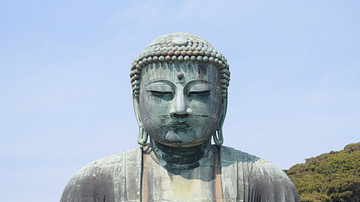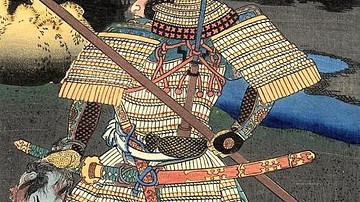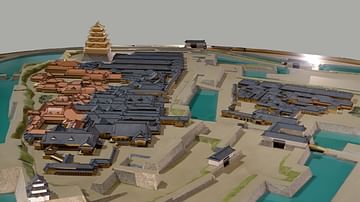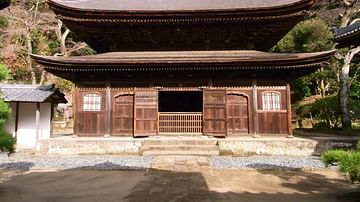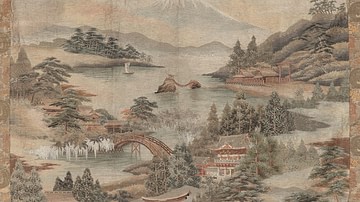Feudalism in medieval Japan (1185-1603) is the relationship between lords and vassals where land ownership and its use were exchanged for military service and loyalty. Although present earlier to some degree, the feudal system in Japan was really established from the beginning of the Kamakura Period in the late 12th century.
The Japanese shoguns or military dictators replaced the emperor and imperial court as the country's main source of government. The shogunates then distributed land to loyal followers and these estates (shoen) were then supervised by officials such as the jito (stewards) and shugo (constables). Unlike in European feudalism, these often hereditary officials, at least initially, did not own land themselves. However, over time, the jito and shugo, operating far from the central government, gained more and more powers with many of them becoming large landowners (daimyo) in their own right and, with their own private armies, they challenged the authority of the shogunate governments. Feudalism as a nation-wide system thus broke down, even if the lord-vassal relationship did continue after the medieval period in the form of samurai offering their services to estate owners.
Origins & Structure
Feudalism (hoken seido), that is the arrangement between lords and vassals where the former gave favour or on (e.g. land, titles, or prestigious offices) in exchange for military service (giri) from the latter, began to be widespread in Japan from the beginning of the Kamakura Period (1185-1333). The main instigator was Minamoto no Yoritomo (1147-1199) who had established himself as the military dictator or shogun of Japan in 1192. Replacing the dominance of the Japanese Emperor and the imperial court, the new system saw Yoritomo distribute land (which was often confiscated from defeated rivals) to his loyal followers and allies in return for their military service and continued support. Yoritomo was particularly adept at enticing members of the rival Taira clan to his, the Minamoto cause by offering them land and positions if they agreed to be his vassals in the new order.
Unlike in Europe, the feudal system of Japan was less contractually based and a much more personal affair between lords and vassals with a strong paternalistic influence coming from the former, who were often referred to as oya or 'parent.' This 'family' feel was further strengthened by the fact that many lord-vassal relationships were inherited. The system allowed the shogun to have direct control of most of his territory, but the lack of formal institutions of government would be a lasting weakness of the shogunates as personal loyalties were rarely passed on to successive generations.
Jito
Some of the loyal followers of the shogun received many estates (shoen), which were often geographically disparate or distant from their traditional family homes, and so, rather than manage them directly themselves, they employed the services of an appointed steward (jito) for that purpose. Jito (and shugo - see below) was not a new position but had been used on a smaller scale in the Heian Period (794-1185) and, appointed by the shogunate government, they became a useful tool for managing land, taxes and produce far from the capital. Here, too, is another difference with European feudalism as stewards never (officially) owned land themselves, that is until the wheels started to come off the feudal system.
Jito literally means 'head of the land', and the position was open to men and women in the early medieval period. Their principal responsibility was to manage the peasants who worked their employer's land and collect the relevant local taxes. The steward was entitled to fees (about 10% of the land's produce) and tenure but was often bound by local customs and also held accountable to such national law codes as the Goseibai Shikimoku (1232). In addition, aggrieved landowners and vassals could, from 1184, turn to the Monchujo (Board of Inquiry) which looked after all legal matters including lawsuits, appeals, and disputes over land rights and loans. In 1249 a High Court, the Hikitsukeshu, was formed which was especially concerned with any disputes related to land and taxes.
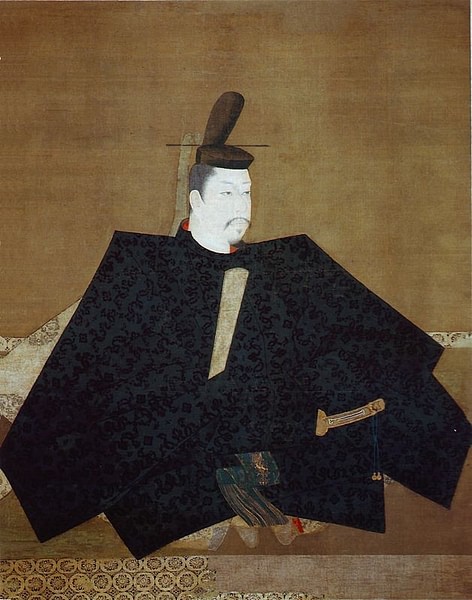
Many jito eventually became powerful in their own right, and their descendants became daimyo or influential feudal landowners from the 14th century onwards. These daimyo ruled with a large degree of autonomy, even if they did have to follow certain rules laid down by the government such as where to build a castle.
Shugo
Another layer of estate managers was the shugo or military governor or constable who had policing and administrative responsibilities in their particular province. In the 14th century, there were 57 such provinces and so a shugo was involved in several estates at once, unlike the jito who only had one to worry about one. A shugo, literally meaning 'protector', made decisions according to local customs and military laws and, like the jito, they collected regular taxes in kind for the shogunate government, a portion of which they were entitled to keep for themselves. They were also charged with collecting special taxes (tansen) for one-off events like coronations and temple-building projects and organising labour for state projects like building roads and guesthouses along the routes. Other responsibilities included capturing pirates, punishing traitors, and calling up warriors for use by the state - not only in wartime but also as part of the regular rotation system where provinces supplied guards for the capital Heiankyo (Kyoto).
Over time the position of shugo became, in effect, one of a regional governor. The shugo became ever more powerful, with taxes being directed into their own pockets and such rights as collecting the tansen often being given to subordinates as a way to create an alternative lord-vassal relationship without any land exchange being involved. The giving out of titles and organising private arrangements with samurai also allowed the shugo to build up their own personal armies. Following the failed Mongol invasions of Japan in 1274 and 1281, shugo were legally obliged to reside in the province which they administered for greater state security, but whether this was always carried out in practice is unclear. By the 14th century, the shugo had also assumed the responsibilities of those jito who had not become daimyo, and by the 15th century CE, most shugo inherited the position.
Weaknesses of the Feudal System
One of the problems for the jito and shugo was that their authority out in the provinces, far from the central government, often relied on the goodwill of the locals, and when the shogunate government was weak - as it often was - samurai warriors and ambitious landowners often ignored demands for taxes or even took matters into their own hands and overturned the established arrangements of lord and vassal to increase their own power and wealth.
An additional weakness in the system was that jito and shugo depended entirely on local sources for their income, not the central government and this meant that they often made entirely self-interested arrangements. Thus, the shogunate itself became a largely irrelevant and invisible institution at a local level. Farmers often made private deals with officials, giving, for example, a small parcel of land in exchange for a delay in payment of taxes or a negotiated percentage in order to pay their expected fees annually. As a consequence, the whole setup of land ownership in Japan became very complex indeed with multiple possible landowners for any stretch of land: private individuals (vassal and non-vassals), government officials, religious institutions, the shogunate, and the Crown.
Yet another problem was that when jito inherited from their fathers there was often not enough money to make a living if the rights of income had to be distributed amongst several siblings. This situation led to many jito getting into debt as they mortgaged their right of income from a given estate. There were additional weaknesses to the feudal system as time wore on, too, namely the difficulty in finding new land and titles to award vassals in an era of stable government.
In the Sengoku Period or Warring States Period (1467-1568) Japan suffered from constant civil wars between the rival daimyo warlords with their own private armies who knew they could ignore the shugo and other officials of the government which was now impotent to enforce its will in the provinces. Land was also ending up in fewer and fewer hands as the daimyo with most military might swallowed up their smaller rivals. By the Edo Period (1603-1868) there would be a mere 250 daimyo across the whole of Japan. The phenomenon of new rulers overthrowing the established order and of branch families taking the estates of the traditional major clans became known as gekokujo or 'those below overthrowing those above.'
The consequence of this social and administrative upheaval was that Japan was no longer a unified state but had become a patchwork of feudal estates centred around individual castles and fortified mansions as loyalties became highly localised. Villages and small towns, largely abandoned by the government, were obliged to form their own councils (so) and leagues of mutual assistance (ikki). Not until Oda Nobunaga (1534-1582), who defeated his rival warlords in the central part of the archipelago in the 1560s, did Japan begin to look like a unified country again.

With the arrival of the much stronger Tokugawa Shogunate (1603-1868) the daimyo were finally put in their place and severe restrictions imposed on them. These included a ban on moving their troops outside of their area and not being able to make political alliances in their own name, build more than one castle, or marry without the shogun's approval. The feudal system did, nevertheless, continue in the guise of samurai swearing loyalty to their particular daimyo up to the Meiji Period (1868-1912), even if there was now a prolonged period of relative peace and military service was less needed than in medieval times.
From the 17th century, then, the Japanese feudal system was, instead of being a nation-wide pyramid structure of land distribution, largely one of local samurai warriors offering their services to a large estate owner or warlord in exchange for use of land, rice, or cash. It is for this reason that the bushido or samurai warrior code was developed which aimed to ensure samurai remained disciplined and loyal to their employers. Meanwhile, increasing urbanisation as people moved from rural life into the cities with their greater employment opportunities, and the ever-rising number of those involved in trade and commerce meant that the old feudal system was applicable to fewer and fewer people as Japan moved into the modern era.
This content was made possible with generous support from the Great Britain Sasakawa Foundation.

